Try Walking Lunges for Lower-Body Strength, Size and Stamina
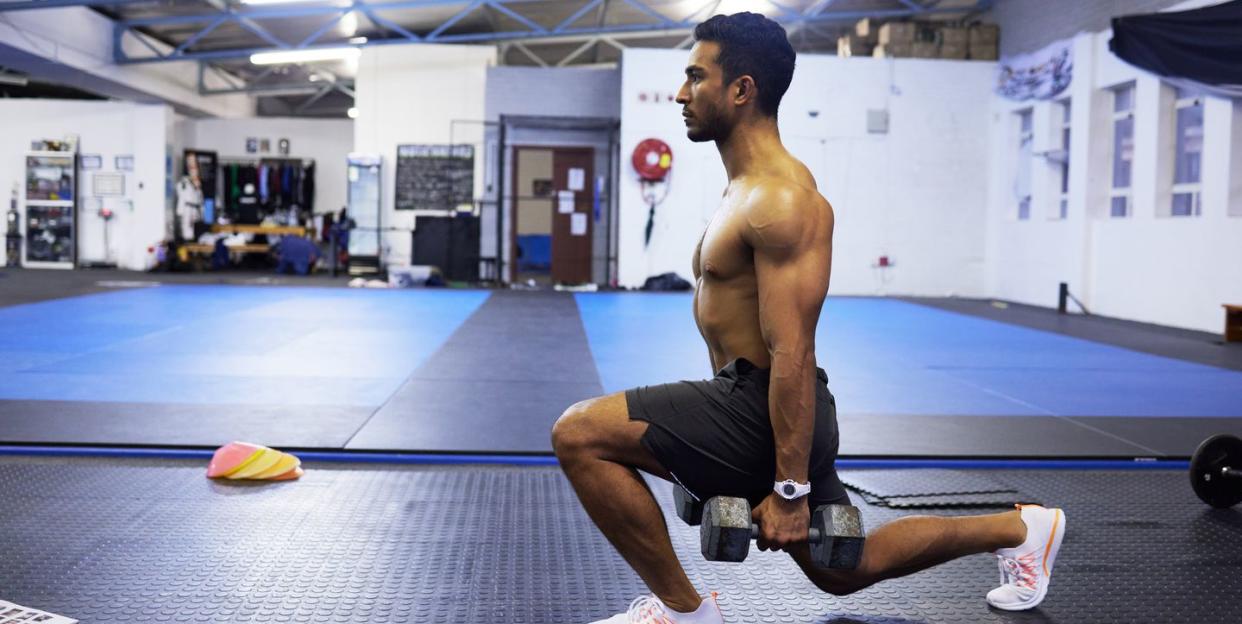
Walking lunges are one of the most effective, yet underrated, leg exercises. They're a variation of the forward lunge, already a pretty solid choice when it comes to increasing leg strength and size. Targeting your quads, glutes and hamstrings, lunges can rapidly build explosive power, even out imbalances between your legs, and are a go-to move in the gym, whatever your strength-training goals. Some also classify the lunge as a key fundamental, or basic, movement pattern, providing practical benefits in helping you move optimally outside the gym, too.
You get it, lunges are great. However, we're talking about walking lunges, upping the ante by adding some locomotion, making this a dynamic exercise that requires much more stability, balance, coordination and awareness of your body in space (also known as proprioception), especially as you increase the load. Steve Chambers, PT at Ultimate Performance and celebrity trainer, went the extra mile to walk us through this key exercise.
Which Muscles are Worked in Walking Lunges?
glutes: the glute max is the main muscle used to flex (close) your hip joint, helping you to move your leg towards your hip when descending into the lunge
quads: these assist in flexing your hip when you lunge, and extending (straightening) your knee when you stand up
hamstrings: they help to bend
forearms (grip strength)
How to Do Walking Lunges
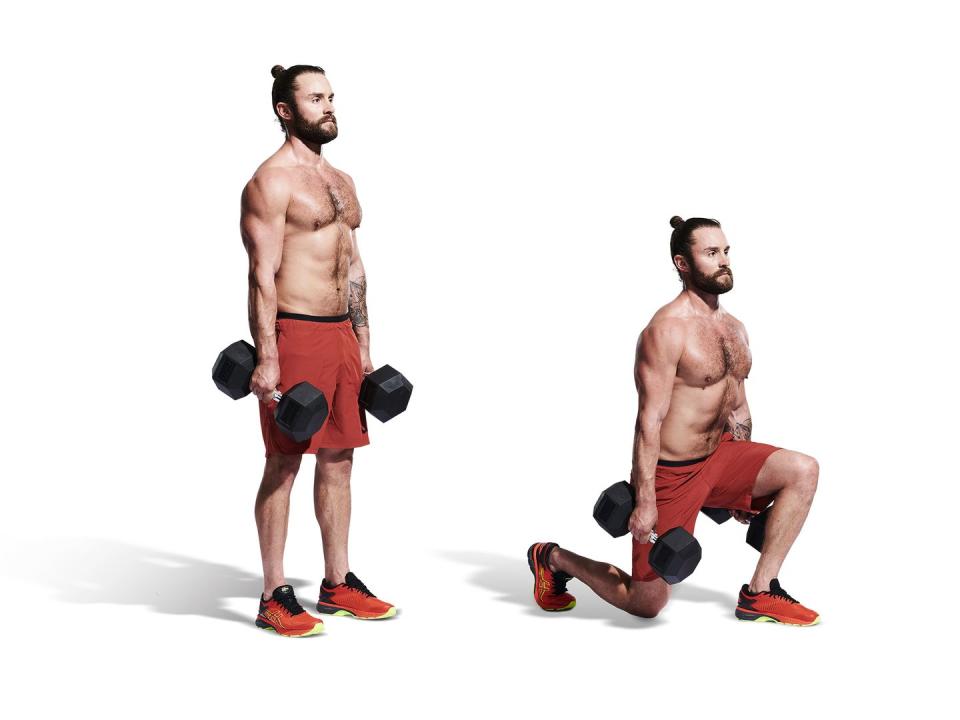
(A) Start by standing straight with a dumbbell in each hand. Your feet should be hip-width apart, your chest up, and your core engaged.
(B) With one leg, take a big step forward and place the foot flat on the ground. Bend both knees and lower down under control until both your knees are bent at 90° and your front thigh is parallel to the floor. Keep your front heel down throughout the lunge.
(C) Push through the front foot and bring your back foot forwards stepping straight into another forward step. Repeat on the other side. Keep your hips square and feet facing forwards throughout the movement and keep the range of motion consistent throughout.
Walking Lunge Tips
1.Regress the exercise by bringing your feet together between each rep
Do this rather than stepping straight into the next lunge, suggests Chambers.
2. You may wish to add extra elements of difficulty into your walking lunges
Hold the dumbbells overhead or front-racking them, rather than having them by your side, incorporating Russian twists or rotations after each lunge to work your obliques (side abs).
3. To increase the emphasis on your glutes, let the dumbbells travel further towards your feet
This means you'll lean forward slightly rather than keeping your trunk vertical, engaging your glutes and hamstrings more. A study in the Journal of Orthopaedic and Sports Physical Therapy found that performing a lunge with the trunk forward increased the recruitment of the hip extensors (i.e the glute maximus and your hamstrings), although your glute medius will be activated to.
Common Walking Lunges Mistakes
1. Not getting deep enough
Chambers emphasises getting the perfect range of motion and 'really hitting that depth so the hamstrings of your leading leg are parallel to the floor' and your knees form 90-degree angles. Lower with control, too, so as to engage the muscles on the eccentric portion of the move. Keep your stride length consistent and try not to take shorter steps.
2. 'Falling' forwards
'One of the most common mistakes people make when performing walking lunges is that people "fall" forward at the torso when lowering, and then "peel" themselves back up as they bring their feet together. This puts undue pressure on the spine', notes Chambers. Keep your torso upright. Your neck should be neutral and your chest tall. 'Don’t let your ego get in the way,' warns Chambers. 'If you’re losing form, the weight is too heavy.'
3. Not keeping your knees in line with your feet
'Most people favour one leg over another because one outer quad head (vastus lateralis) is often stronger unless you've corrected that imbalance', says Chambers. That can pull your knee out of line when performing walking lunges, so it’s important to ensure you track your knees and keep them in line with your feet.
'Knees caving in and excessive foot pronation (when your weight falls on the inside of your foot) is common', he adds.
Walking Lunges With a Barbell vs With Dumbbells
If you prefer to use a barbell, the exercise is largely the same, although Chambers advises loading the barbell in a squat rack before placing it across your back and shoulders. You can also try front-rack walking lunges, or even with kettlebells.
1.Walking lunges with dumbbells may be safer
Chambers says, 'If you reach failure, either technical or muscular, you can simply drop the dumbbells on the floor. Safely dropping a barbell from your shoulders to the floor increases the risk of injury.
2. You may be able to go heavier with a barbell
On the other hand, the heavier the dumbbells you use, 'the more people struggle to maintain a good grip of dumbbells' - effective for overall shoulder and forearm strength - whereas the weight of a barbell is 'distributed across your back and shoulders, targets the erector and core muscles, and has the added security of both hands gripping the bar,' so some people find they can go heavier with barbell lunges.
What Are the Benefits of Walking Lunges?
1. Build size and strength in your legs
By hitting so many of your lower-body muscles, the lunge will promote leg hypertrophy and generally increase lower-leg mass. Resistance training 'creates microscopic tears in your muscle tissue,' explains Chambers. 'During rest, cells called fibroblasts repair it. This helps the tissue heal and grow, resulting in stronger muscles.' Progressively overloading using increasingly heavy weights, higher reps or more sets means your body has to adapt, resulting in increased gains.
As Andrew Tracey, MH's fitness director suggests, loaded locomotion, including heavy carries and walking lunges, are 'the most practical way to express your strength', and being able to perform them may have even been 'an enormous evolutionary advantage' for our ancestors. Travelling with a considerable load as a workout taps into that primal instinct to develop strength to survive: 'You were built to carry heavy stuff, reasonably long distances. And, you were built to carry things approximate to your own bodyweight, far and fast.'
2. They’re incredibly powerful for cardiovascular health and building fitness
Because walking lunges combine conditioning and strength, they are excellent for improving cardiovascular health and reducing your risk of heart disease, high blood pressure and stroke.
As lunges are compound exercises that involve several different muscles (as opposed to single-joint, isolation moves), they require a lot of 'full-body effort, which means your metabolism will kick into fifth gear, you'll get your heart racing, and you’ll burn a lot of calories', explains Chambers.
3. May correct imbalances
As a unilateral exercise, the walking lunge works one side of your body at a time, helping to even out any muscle imbalances and developing each both legs equally.
4. Improve coordination
Research in the Journal of Strength and Conditioning confirmed that unilateral exercises increase balance requirements by decreasing a move's stability, developing coordination and stabilisation that a bilateral movement might not.
5. Enhances practical functionality
Practising this movement may also improve your performance in similar activities like running or sprinting, and climbing stairs that the walking lunge mimics.
6. Promotes hip mobility and flexibility
Incorporating movements that engage your hip flexors (five key muscles that bring your leg closer to your chest) counteracts tightness and weakness that arise from sitting from extended periods of time.
Are Walking Lunges Better Than Stationary Lunges?
'Walking lunges require greater skill, because you need greater balance and there are more moving parts, so there is greater risk of losing form,' explains Chambers. Because static lunges require less balance and co-ordination, they’re an easier move.
However, walking lunges are more effective if leg hypertrophy is your goal. 'Because both legs need to work in harmony together, it will recruit more muscles and muscular contraction, balance, and require significantly more effort than static lunges, all of which will contribute towards building stronger muscles and improving your mobility.
Walking Lunges Variations
'You can practise other lower-body exercises that involve alternating unilateral leg movements that are also very effective for lower-body strength,' says Chambers.
1. Forward lunge

(A) Start standing tall, feet under your hips, chest proud and core tight with the dumbbells in each hand, and your arms hanging at your sides. To help your balance, fix your eye line two metres in front of you.
(B) Lift one foot off the floor and take a long step forward and plant it in line with your hips. Visualise stepping on 'train tracks' instead of a 'tightrope'.
(C) Sink the back knee so it hovers just off the floor. Your front quad and back shin should be parallel to the floor with right angles at both knees.
(D) Keep your core engaged and push through the front heel back to standing. Repeat on the same side for the allotted reps and then change to the other side.
2. Reverse lunge

(A) Stand with your feet hip-width apart. Keeping your chest up at all times, take a step back with one leg, bending your front knee until the back knee almost touches the ground and both knees are bent at 90 degrees. .
(B) Push through the front heel back to standing. Repeat with the other leg.
3. Split squats
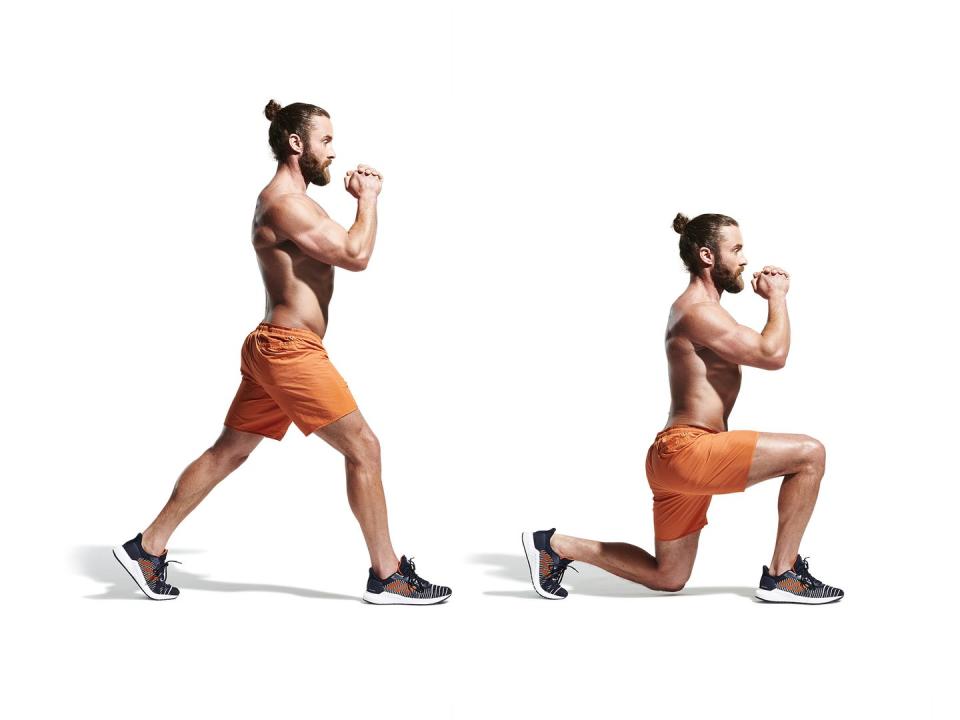
(A) Stand with your feet shoulder-width apart. Step back into a reverse lunge until your knee touches the ground and your knees form 90-degree angles.
(B) Drive through your front heel to stand back up. Repeat on the other side.
4. Bulgarian split squats
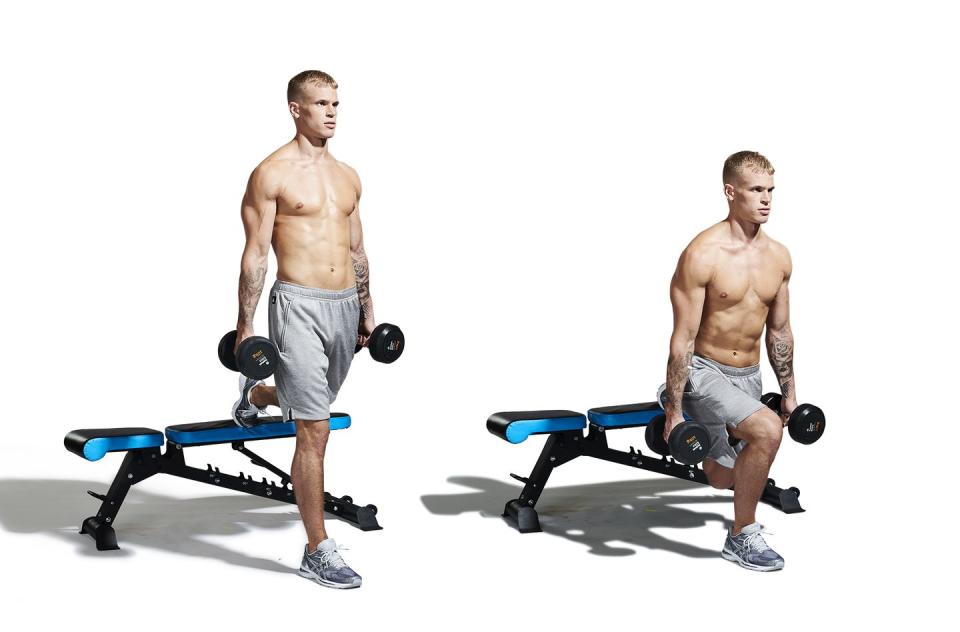
(A) Stand 2-4 feet in front of a bench (depending on your height), facing away.
(B) Have one leg resting on the bench behind you, laces down, with your feet in line with your hips.
(C) Sink your body down until the knee of your back leg almost touches the floor. The front knee should be at a right angle.
(D) Push up through your front foot to return to the start position. Repeat on the other side.
5. Jumping lunge
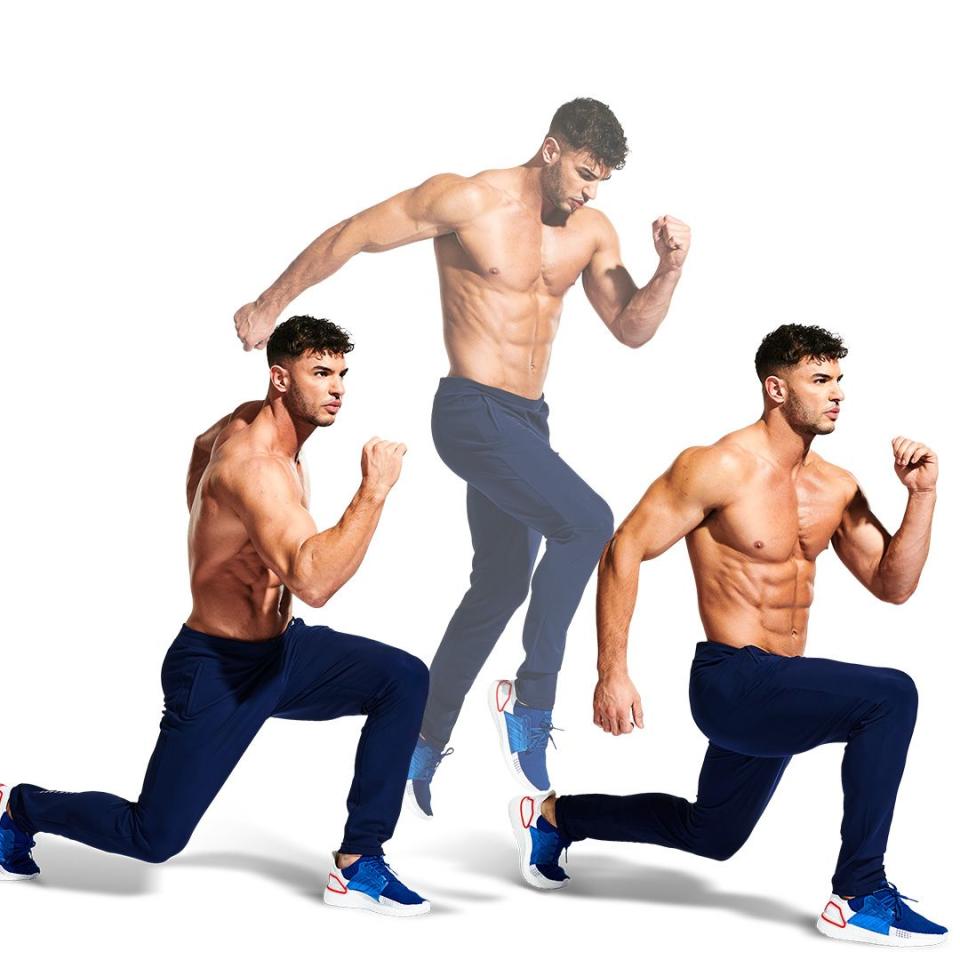
(A) Start in a lunge position with right angles at both knees. Brace your core and explode into a jump, adding a cardio element and introduces explosive power.
(B) Switch legs in mid air and land softly into another lunge.
6. Single-leg Romanian deadlifts
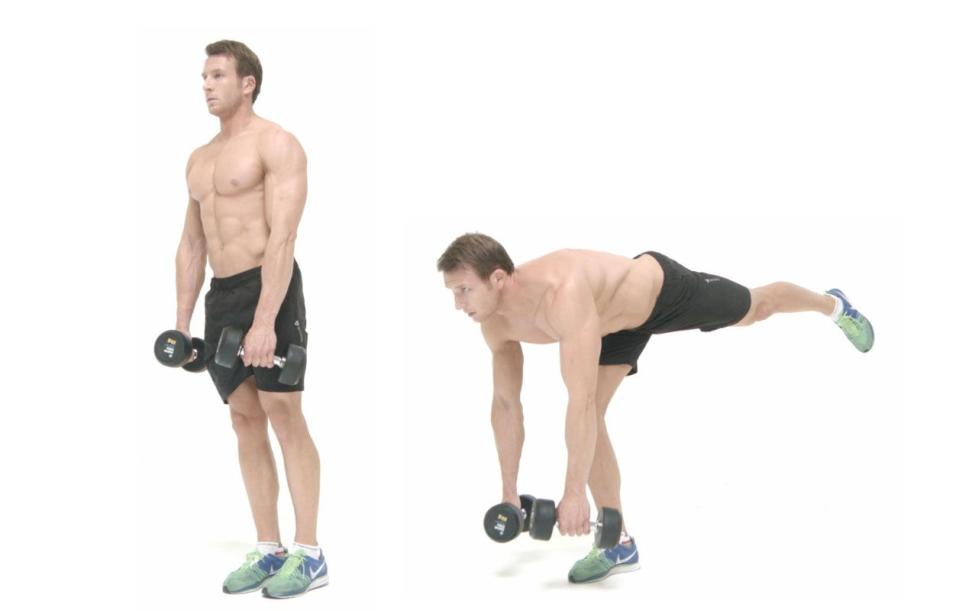
(A) Start standing on one leg, keeping your hips and ribs aligned, facing forward and not rotating. You can slightly bend the knee of the leg you're balancing on.
(B) Hold your weights in front of the standing thigh. Send your hips behind your heels with a flat back as if you're 'shutting a car door' - don't allow your hips to rotate up. Keep your knee directly above your heel and shin vertical to the floor.
(C) As you lower the weight, keep your shoulder blades drawn towards each other and head in line.
(D) Feel a stretch in your hamstrings. When the weight is below your knees, send your hips forward to return to the starting position.
7. Weighted step-ups
(A) Stand with a step, box or bench in front of you. Hold a set of dumbbells in your hands, arms hanging at your sides. Step up onto the raised platform with one foot, pressing through the heel to straighten your leg, keeping your torso tall and your core braced. Your knee should track slightly outwards. Bring your other foot onto the platform to meet it.
(B) Bend your knee and step off with your second foot, then bring your first foot back down to meet it. Repeat on the other leg.
8. Pistol squat
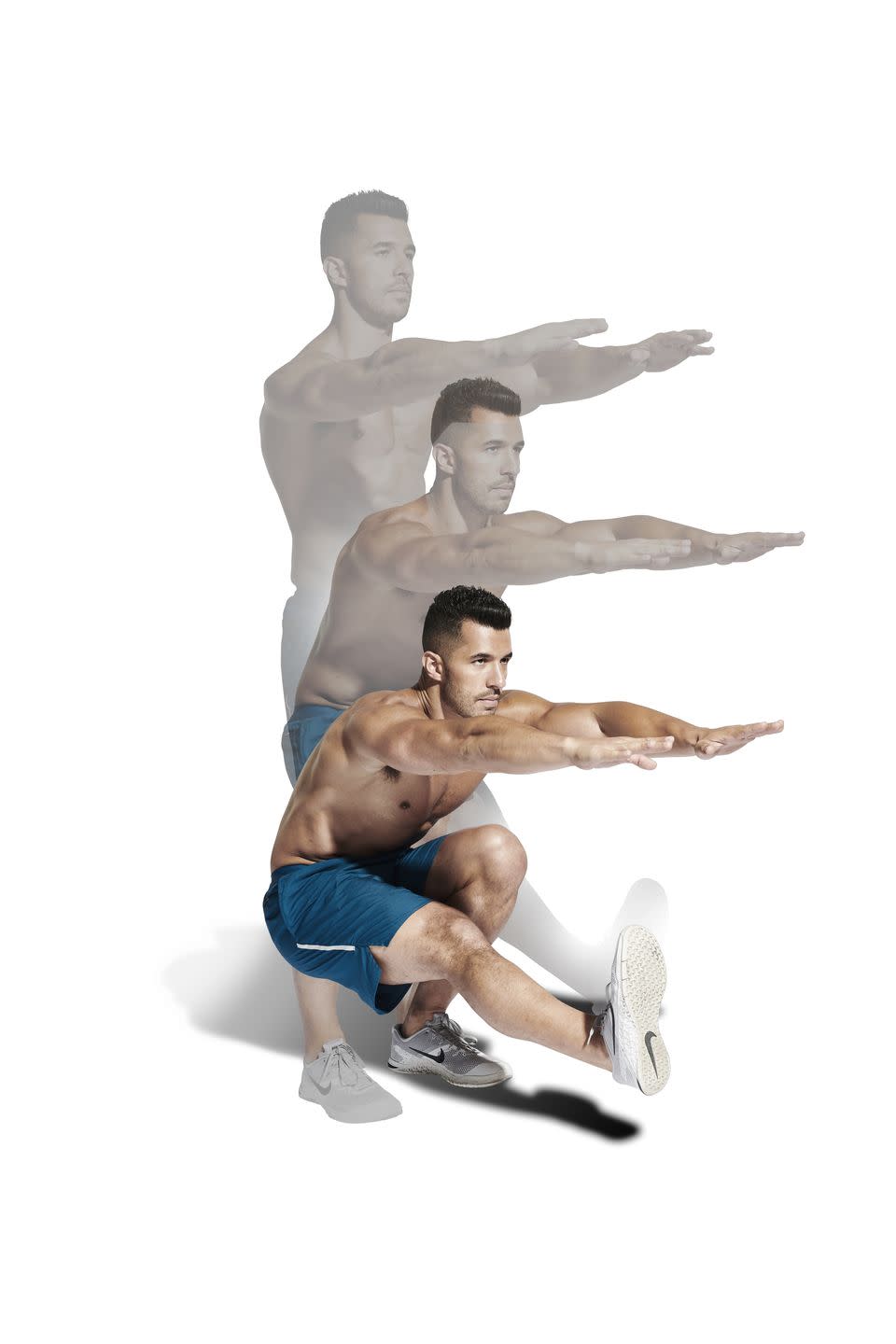
(A) Stand with your feet under your hips and lift one leg off the floor with a flexed foot. Squat down with your weight in the supporting leg, shifting your torso to counterbalance. Try to keep your heel firmly planted into the floor as you lower as far as possible.
(B) Drive through the supporting leg and push back up to the start position, then switch legs and repeat.
Walking Lunges Workouts
'One of the best ways to increase the size and strength of your legs is to use a mixture of high-rep exercises and low-rep exercises within the same routine,' says Chambers.
Here, you have the ‘heavy’ work at the beginning, working your hamstrings and pairing with the heavy squats.
4 sets of:
1A) Prone leg curl x 8
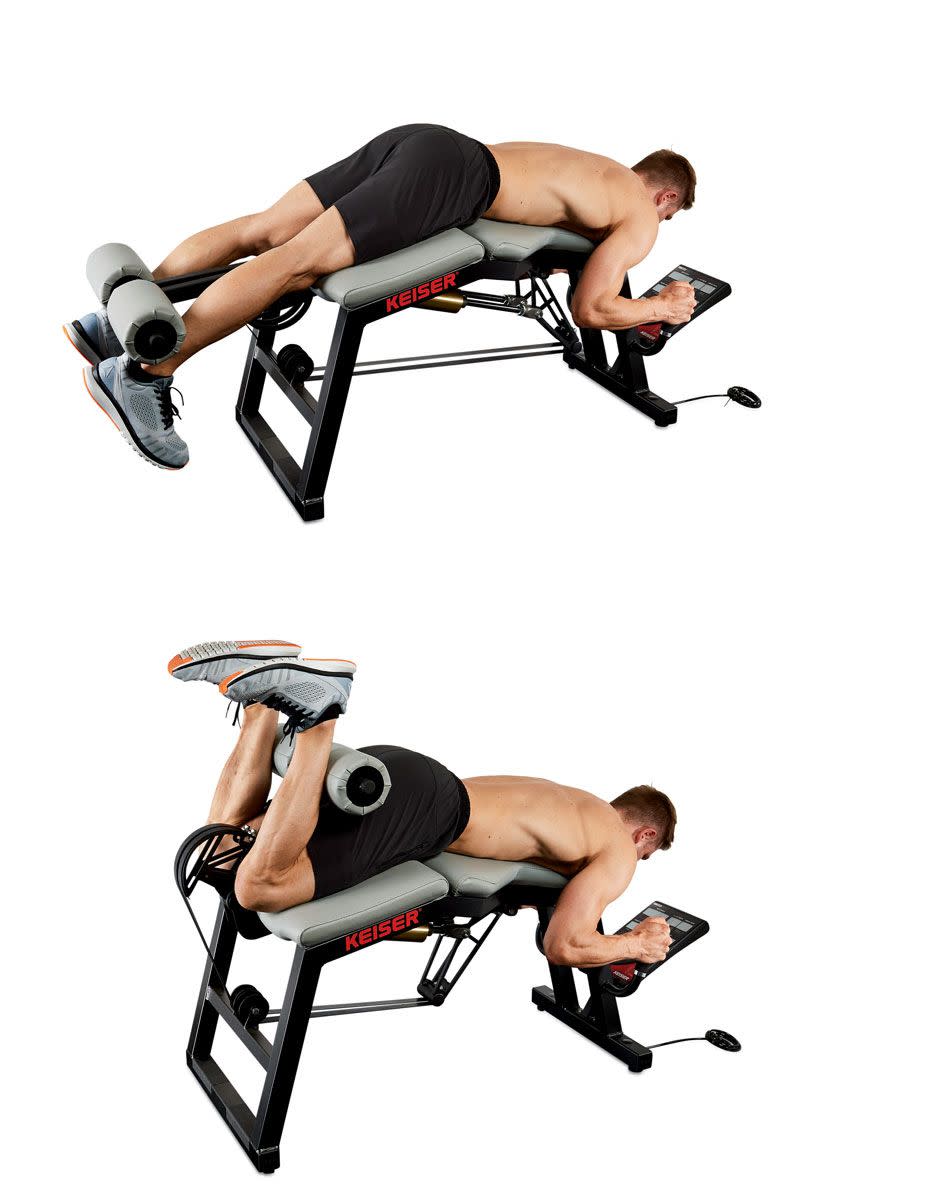
Tempo: 3010
Rest: 90 secs
1B) Barbell front squat x 6
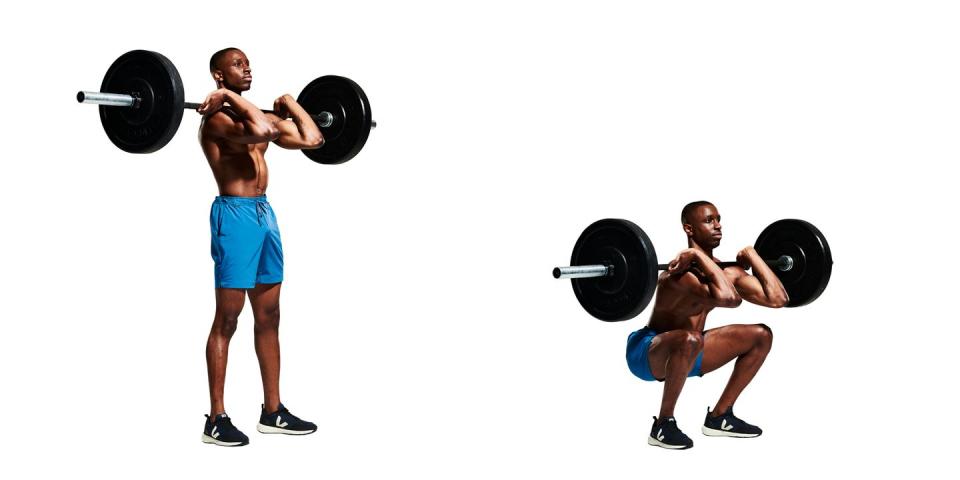
Tempo: 3010
Rest: 90 secs
Second, you destroy the quads with some tri-sets (where the walking lunges come in).
4 sets of:
2A) Walking lunges x 20m
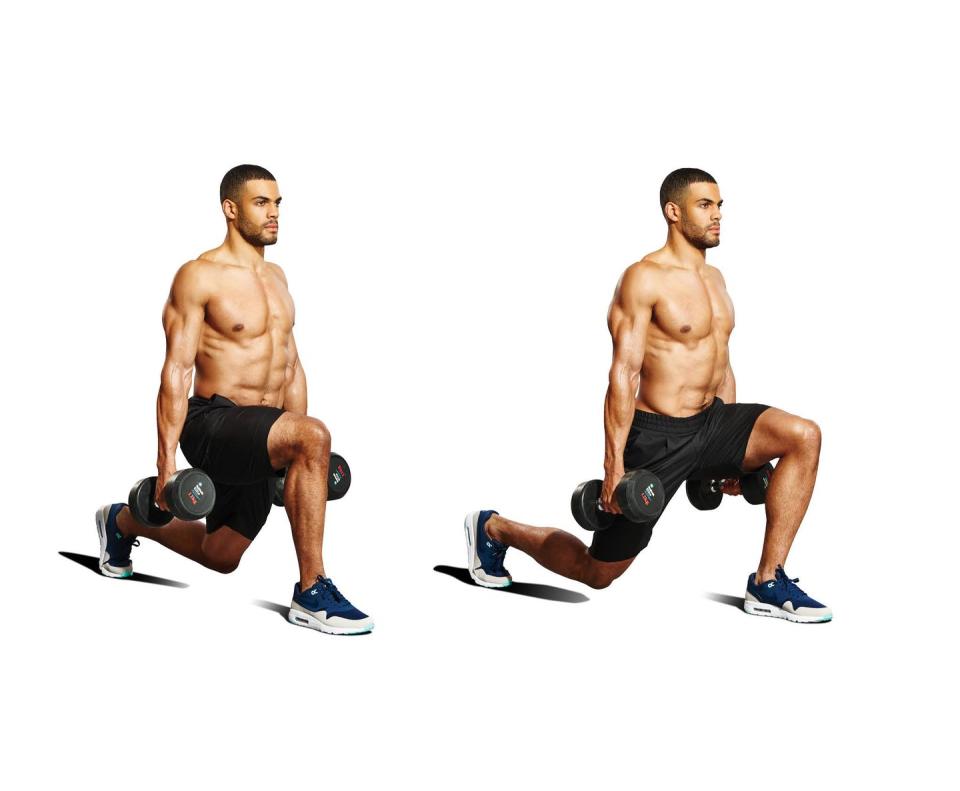
Tempo: 2010
Rest: 10 secs
2B) Dumbbell squats x 10
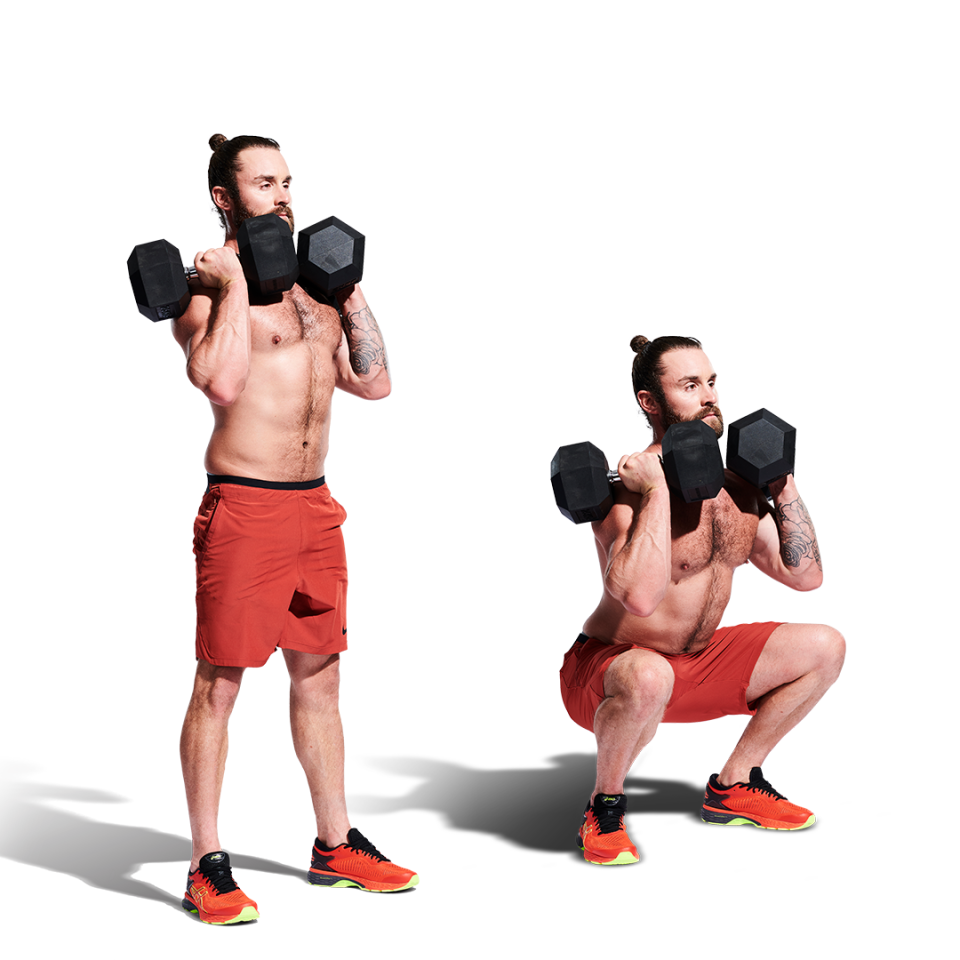
Tempo: 3010
Rest: 10 secs
2C) Leg extensions x 10
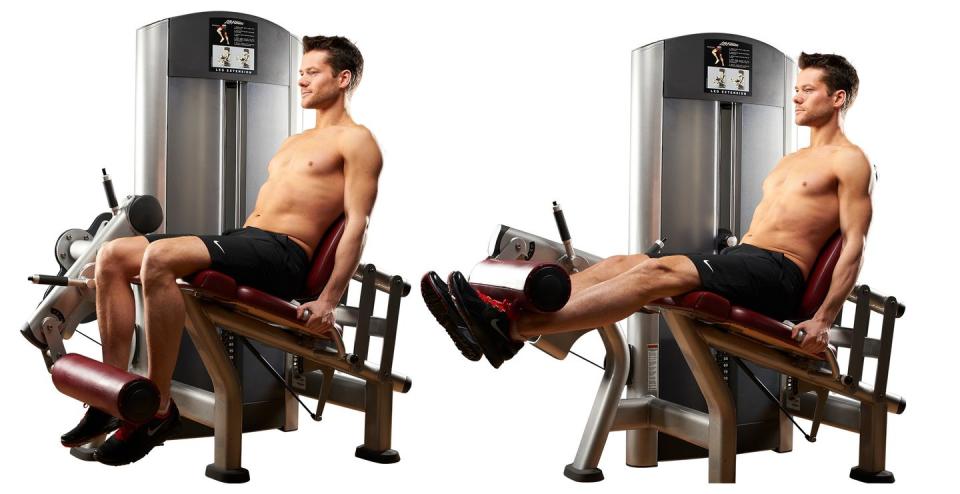
Tempo: 2012
Rest: 120 sec
Third, back to hamstrings, but this time focusing on the hip extension portion, and specifically, the stretched position.
3 sets of:
3) Dumbbell Romanian deadlift x 12

Tempo: 3010
Rest: 90 secs
To finish with, an all-out set of 50 reps on the leg press. You can rest-pause this two or three times in order to hit the rep.
4) 45-degree leg press x 50 (in as few sets as possible)
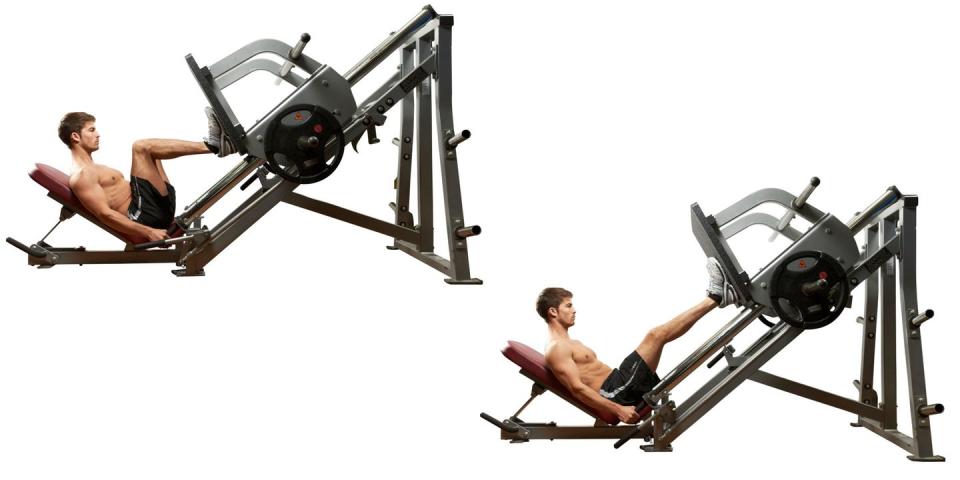
Tempo: 2010
You can perform the walking lunges as the final exercise ‘finisher’, swapping the leg presses for walking lunges – just make sure you drop the 50 leg presses to 4 sets of 12, and up the walking lunges from 4 sets of 20m to 1 set of 25 lunges per leg.
More lunge workouts:
Our 330-rep lunge ladder is the ultimate bodyweight leg burner
Lunge your way to stronger legs with this functional lower-body workout
Take on Our 30-Minute Lunge and Lift Challenge for a Serious Leg Day Sesh
You Might Also Like


